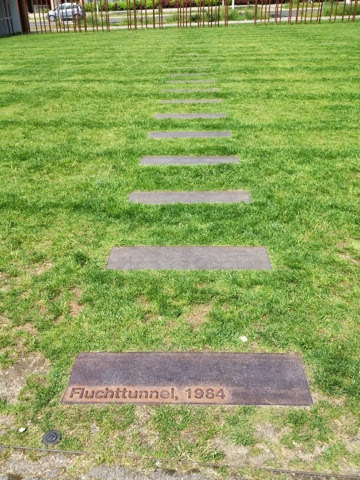Stasi Headquarters. An unadorned building right off the metro.
We were given the incredible opportunity to tour the archives at the former Stasi Headquarters, officially known by the (very German style) name as the Federal Commisioner for the Records of the State Security Service of the former German Democratic Republic. After a brief overview of the agency’s history and the efforts of modern archivists, we were led into the archives by our wonderful guides Dagmar and Gunter. The first item of interest we encountered were the Pater Nostra, or Our Fathers. Named for the tendency of passengers to pray for their safe delivery, these glorified dumbwaiters took us two-by-two up to the fourth floor.
We then traveled to the Berlin Wall Memorial at Bernauerstrasse. The memorial covers some three city blocks and details the history of the wall on this street. The exhibit traced the development of the wall between 1961 and 1989 as well as detailing the numerous escape attempts -- including tunnels that were marked with stones on the memorial's grounds.
The memorial culminates with an elevation platform that allows one to look at the entirety of the wall complex: the inner wall to the east, the outer wall to the west, and the so-called death strip in between, complete with watchtower.
After our examination of the GDR, we looked for a place to eat. A couple classmates and I saw a small Turkish restaurant that was very close to the museum, so we decided to stop there and get a quick bite. After taking a small bite out of a chicken döner we all felt the same way. We all thought it was one of the most amazing things we ate in Berlin so far. More immigrants from Turkey are coming into Germany so that type of culture is becoming very popular in this country. The biggest mistake I have made in Berlin so far would probably be going to McDonalds the first day here. The food in Germany tastes different then the food in America but it is a good different. This is going to be one of the several things I will miss about Berlin: the amazing variety of different food from different types of cultures.
The images below are the döner that we all got the privilege to eat and the restaurant where we ate.


Jewish Museum:
When walking into this beautiful big yellow building, I wasn’t really sure what to expect. When inside, we found out that this museum is one of the largest Jewish Museums in all of Europe. Right then and there I knew we would all have a great experience. When we started our individual tour, I first saw many families’ personal items such as letters, silverware, cameras, and other such things. What really affected me were the many stories about the lives of Jews in Central Europe. An example of one of these stories was a love story between a Jewish woman and a German soldier’s wife. To think that these two completely different women can somehow diverge from societal norms and help each other out in a time of need is pretty amazing. The architect Daniel Libeskid created another part of the museum which many of my classmates found interesting. It was a room where 10,000 faces covered the floor, representing all the innocent victims of war and violence. The last thing our group had the chance to see was the Tower Terror. It was a room where the light only came from the sun and it was later interpreted as a commemorative space for the victims of the holocaust. This museum was a great experience and the provocative design of the building only contributed to the experience.
Kufurstendamm or popularly known as Ku’Damm:
After visiting the Jewish Museum, we decided to go to one of the most popular shopping district in all of Berlin. This place had sports shops, quality clothing stores, and restaurants. There were even two cages filled with tropical birds in between a square-shopping plaza. At the end of our shopping experience, each person in our small group had at least two bags of souvenirs, clothes and even athletic ware. The Kufurstendamm was one of the biggest shopping centers I have ever been to and it was a lot of fun to be there with all my friends.


We concluded the day with a visit to the Reichstag dome. After walking around the top of the building, we were able to ascend to the top of the dome, where we had an outstanding view of Berlin at night. It was a fitting conclusion to a great day.







No comments:
Post a Comment